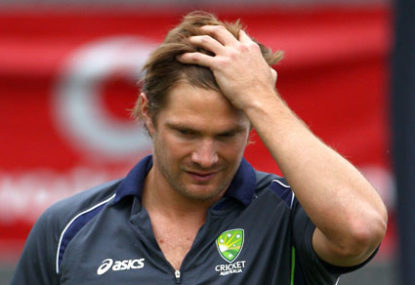Australian cricket history was made in Dubai yesterday with Mitch Marsh debuting in the baggy green.
His arrival on the scene produced for the first time in Australian cricket a father (Geoff) and two sons (Mitch and elder brother Shaun) had all played Test cricket. They joined the Hadlees from New Zealand and the Armanaths from India as the only families to achieve the feat.
The youngest Marsh equipped himself well, returning figures of 11-4-18-0 as Pakistan batted its way to 4-218 at stumps.
FULL PAKISTAN VS AUSTRALIA SCORECARD
Marsh made the tour party as a result of yet another injury to Shane Watson who is sidelined with a calf complaint.
What Marsh’s arrival on the scene means to the former Test vice-captain will be one of the sub-plots over the next few weeks in the Emirates.
Alas for Watson, injury has been a near constant companion throughout his international career which started in the one-day arena in March 2002.
He debuted at Test level on January 2005.
Since then he has managed 52 matches out of a possible 107 Tests over the period.
Of the three forms of the game, it has been the Test arena which is Watson’s least successful.
Renowned as a power-hitter in the abbreviated forms of the sport – he possesses a career-strike rate of 90 in ODIs and 146 in T20s. But he has seldom approached his batting at Test level with anywhere the same mental approach.
While bedecked in creams he has a strike rate of 53, a mark less than Justin Langer’s – a man who was often pigeon-holed as a grafter.
Watson’s approach and mindset at Test level has often been diametrically opposed to the that which he displays in the limited-overs forms.
During his Test career, Watson has batted everywhere from one to seven in the order.
Nowadays he sees himself as an opener but even if he was fit he would not be occupying that position, with David Warner and Chris Rogers ensconced at the top of the order.
Watson’s last Test was in Cape Town in March – ironically returning to the side having missed the opening matches of the series with a calf strain – where he batted at number six in the first innings and at four in the second.
During the five-Test home Ashes series that preceded the South African tour Watson batted exclusively at number three.
However his injury in South Africa saw him lose that position to rookie Alex Doolan.
The Tasmanian returned an average of 31 from the three Tests – not a stellar performance but his maiden series was against an attack that boasted Dale Steyn, Morne Morkel and Vernon Philander.
He remains the incumbent on the back of a century in the warm-up match against Pakistan A heading into the current Test.
If Doolan performs in the current series it will close the door on Watson for the first-drop position heading into the four-Test home series against India this summer.
Unless something goes awry ahead of the Gabba Test next month Michael Clarke and Steve Smith will be batting at numbers four and five respectively.
That leaves the number six all-rounder position – currently occupied by Marsh – as perhaps Watson’s best chance of forcing his way back into the side.
The selectors in recent times – including current coach Darren Lehmann – have said that for Watson to be selected he has to be able to bowl.
With the litany of injuries and the advancing of the years one wonders just how much bowling Watson has left in him.
He has always been seen as a genuine all-rounder although his output with the ball has been reasonably thin throughout his Test career, with an average of just 15 overs per match.
In recent times when he has bowled he has been used more of a stopper than a wicket-taker.
Twenty-two year-old Marsh, who has had his own problems with back injuries in recent seasons, is capable of bowling at genuine pace. He can tickle the 140km/h mark.
In his 38-match first class career, he has captured 56 wickets at 26.9, a fair record given he was restricted by injury to just batting in several of those games.
Marsh has been on the selectors’ radar for quite some time, however his growth in the game has been stunted not only by injury but by off-field alcohol related incidents.
Things seem to have turned around significantly of late, with Clarke extolling Marsh’s newfound maturity and even going so far as to say he believed he possessed the requisites to be a future skipper.
As a batsman he is a clean striker of the ball in the mould of all-rounders of yesteryear like Ian Botham, Imran Khan and Kapil Dev.
Currently his batting in long-form ranks is the weaker suit, although he does boast a first class best of 211.
Marsh is seen as being very much a work in progress and given his age he certainly has time on his side.
The same cannot be said of Watson. He is in his 34th year.
Despite obvious talent the powerfully built right-hander has failed to truly deliver with the bat with his 97 Test innings producing an average of just 36.2.
His inability to convert solid starts into sizeable hundreds has been a definite Achilles heel – of the 26 times he has passed 50 at Test level, only four times has he gone on to post a century.
There is every prospect that Watson may have played his last Test and his future could be limited to short-form cricket.
Should that be the case, his Test career will be forever viewed as one that fell well short of its potential.





























































































